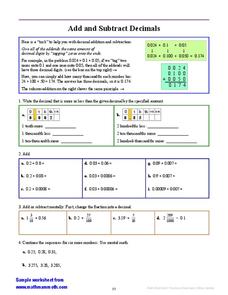Math Salamanders Ltd.
Adding 1s, 10s, 100s, and 1000s
In this addition activity, students complete a 13-row chart. They start with three or four-digit numbers and add 1, 10, 100, or 1000 to each number to fill in the chart. The last four questions require subtraction because the initial...
Math Mammoth
Grade 1 Worktext
Use graphing, counting, and number lines to help first graders learn about addition and subtraction. An array of worksheets and activities are an excellent resource for your math lesson, whether you are focusing on counting skills...
Illustrative Mathematics
Area of a Trapezoid
Here is a straightforward example of how to apply the Pythagorean Theorem to find an unknown side-length of a trapezoid. Commentary gives additional information on proving that the inside of the trapezoid is a rectangle, but is...
K!2 Reader.com
Interrogative Pronouns
To whom will you assign this exercise that focuses on interrogative pronouns? Your students, of course! Learners complete 18 sentences by adding in the correct interrogative pronouns. The page includes a list of pronouns to choose...
EngageNY
Describing a Distribution Displayed in a Histogram
The shape of the histogram is also relative. Learners calculate relative frequencies from frequency tables and create relative frequency histograms. The scholars compare the histograms made from frequencies to those made from relative...
Kelly's Kindergarten
July Daily Activities
Concerned about your learners forgetting what they've learned during summer vacation? Use a learning guide to keep them busy every day of the week. With activities about writing, drawing, counting, adding, and time, your kids will be...
Curriculum Corner
Learning Fun with Hershey Bars
Compiled of 18 task cards and five worksheets, young mathemmaticians practice solving fraction word problems and other fraction-based activities with a Hershey Bar. The packet comes with sheets to record and keep track of all of the task...
Lorain County Community College
Solving Linear Equations
Put your mathematicians to the test and see if they can solve this worksheet full of multi-step equations with rational numbers. Add, subtract, multiply, and divide with fractions and decimals to solve for x. The top of the worksheet has...
Charleston School District
Negative Exponents Operations
Are exponent rules different if the exponents are negative? Using the definition of negative exponents and the rules of exponents, the resource shows that the rules of exponents hold independent of the sign of the exponent. Practice...
West Contra Costa Unified School District
Solving Rational Equations
Scholars first learn to solve two-step equations with fractional coefficients and constants by traditional methods and by clearing the denominator. They continue by learning another approach to solve two-step equations that have decimal...
Teacher Web
Inferring Character Traits
Learning how to draw inferences from text is a key reading comprehension skill. Here's a worksheet that gives readers a chance to practice by offering 20 descriptive sentences and asking kids to identify the inferred character...
Winston-Salem Forsych County Schools
Economics Worksheet Economic Systems and Circular Flow
Agribusiness, human capital, productivity. Find out what your class members know about economic systems and terminology with this two-page economics worksheet that that asks kids to identify terms and concepts.
EngageNY
Addition and Subtraction Formulas 1
Show budding mathematicans how to find the sine of pi over 12. The third instructional activity in a series of 16 introduces the addition and subtraction formulas for trigonometric functions. Class members derive the formulas using...
Pingry School
Comparing Activities of Selected Metals
Don't overreact! A simple experiment demonstrates chemical reactions as scholars mix chemical solutions and metals in a large well plate. They note all changes to the metals, solutions, precipitate, colors, and more. A full data table...
K12 Reader
Add an Appositive 2
Do your kids need additional practice with appositives? A straightforward activity prompts them to rewrite a series of sentences, adding appositives to each one.
Curated OER
Math Addition Practice
When your math whizzes complain that adding two numbers is too easy, you know what to do! This addition worksheet features fifteen equations, each of which has three 2-digit addends. They are required to regroup as they complete these....
Curated OER
Add and Subtract Decimals
In this decimal worksheet, students read about adding and subtracting, then complete a set of 31 problems, adding, subtracting, solving for values of expressions and solving equations.
Curated OER
Real-Life Problems
How much does it cost to mail this letter? Scholars approach the real-life scenario of adding postage as they practice introductory addition. Each letter has a total amount it needs, and learners draw in the appropriately-priced stamps...
Curated OER
Money Addition (F)
In this adding money worksheet, students add European pounds in increments of ten cents to solve. Students solve 20 problems.
Curated OER
Addition Exercises
In this adding one worksheet, students add numbers in a two-column graph to find the sums by adding one to the numerals one to nine in sequence and observe the answer patterns. Students find eight sums.
Curated OER
Adding Coins
In this money learning exercise, 2nd graders count the number of coins to add up the amount of money that is shown. Students respond to 6 questions, writing the amount of money that is depicted on the line beside each picture.
Curated OER
Sharpen Your Skills: Addition and Subtraction
In this addition and subtraction worksheet, learners solve the equations that range from three digits to five digits. Students must either add to solve or subtract.
Curated OER
Counting On Tens
In this counting on tens worksheet, students use a chart from 0 to 50 to add tens to a number. Students start at the specified number, then move as many rows as necessary to add the multiple of ten.
Curated OER
Acids, Bases and Salts
In this acids, bases and salts worksheet, students solve five problems in order to determine the molarity of solutions or the volume of substances to be added to make molar solutions. They also solve five dilution problems about acids.























